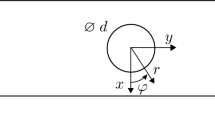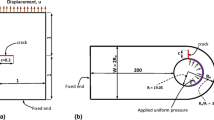Abstract
Investigations were performed for the round-ended straight attachment lug with a single crack emanating from the hole with the weight function method. The weight functions, covering the geometries from W/D=1.5 to W/D=4.0, were generated from the results obtained with a boundary element method using the approximate weight function technique. The results have been given both in the form of analytical weight functions and tabulated dimensionless stress intensity factors for simple normalized powers of the crack line loading. This is a simple straight forward procedure to calculate stress intensity factors once the crack line loading is approximated by a polynomial. The present method is also valid for deriving stress intensity factors and weight functions for general crack configurations.
Similar content being viewed by others
References
J. Schijve, contribution to the Theory of Aircraft Structures, Prof. A. Van der Neut Anniversary Volume, Nijgh-Wolters Noordhoff United Press (1972) 423–440.
L.F. Impellizzeri and D.L. Rich, Fatigue Crack Growth Under Spectrum Loads, ASTM STP 595, American Society for Testing and Materials (1976) 320–336.
R.J.H. Wanhill, Fracture Mechanics Design Methodology, AGARD CP221 (Feb. 1977) 8.
J. Schijve and A.H.W. Hoeymakers, ‘Fatigue Crack Growth in Lugs and the Stress Intensity Factor’, Rept. LR-273, Delft University of Technology, Delft, The Netherlands,July 1978.
T.M. Hsu, AIAA 80–0753R, 18, No. 9 (1981) 755–760.
I.J. Zatz, H.L. Eidinoff and H. Armen, Jr., ‘An Application of the Energy Release Rate Concept to Crack Growth in Attachment Lugs’, Paper 81–0491, AIAA/ASME/ASCE/AMS 22nd Structure, Structural Dynamics and Material Conference, Part 1 (1981) 402–415.
R.V. Van der Velden and E.P. Louwaard, in Proceedings of the 12th ICAF Symposium (1983) 1.5/1–1.5/52.
T.M. Hsu and K. Kathiresan, in Fracture Mechanics: Fourteenth Symposium-Volume I: Theory and Analysis, ASTM STP 791, J.C. Lewis and G. Sines (eds.), American Society for Testing and Materials (1983) I-172–I-193.
J.E. Moon, in Proceedings of the 12th ICAF Symposium (1983) 1.6.
V.E. Saouma and I.J. Zatz, Engineering Fracture Mechanics 20, No. 2 (1984) 321–333.
K. Kathiresan and T.R. Brussat, Advanced Life Analysis Methods-Crack Growth Analysis Methods for Attachment Lugs, Vol. II, AFWAL-TR-84–3080, Wright-Patterson Air Force Base, Ohio (1984).
K. Kathiresan and T.R. Brussat, Advanced Life Analysis Methods-Experimental Evaluation of Crack Growth Analysis Methods for Attachment Lugs, Vol. III, AFWAL-TR-84–3080, Wright-Patterson Air Force Base, Ohio (1984).
N. Gianni, Engineering Fracture Mechanics 22, No. 5 (1985) 829–838.
K. Kathiresan, T.R. Brussat and J.L. Rudd, Journal of Aircraft, 22, No. 9 (1985).
T.R. Brussat, K. Kathiresan and J.L. Rudd, Engineering Fracture Mechanics 23, No. 6 (1986) 1067–1084.
N. Gianni, Fatigue in Mechanically Fastened Composite and Metallic Joints, ASTM STP 947, John M. Potter (ed.), American Society for Testing and Materials (1986) 150–171.
L.A. James and W.E. Anderson, Engineering Fracture Mechanics 1 (1969) 565–568.
K.J. Cartwright and D.P. Rooke, Engineering Fracture Mechanics 6 (1974) 563–571.
A.F. Liu and H.P. Kan, in Fracture 1977, Vol. 3, ICF4, Waterloo Canada (June 19–24, 1977) 657–664.
W.T. Kirkby and D.P. Rooke, Fracture Mechanics in Engineering Practice, Applied Scientific Pub., London (1977) 339.
H.G. Bueckner, ZAMM 50, 9, (1971) 529–546.
H. Tada, P.C. Paris and G.R. Irwin, The Stress Analysis of Cracks Handbook, Del Research Corp. (1973).
J.A. Aberson and J.M. Anderson, in Third NASTRAN User's Colloquium, NASA TMX 2893, National Aeronautics and Space Administration (1973) 531–550.
T.H.H. Pian, O. Orringer and G. Stalk, ‘Numerical Computation of Stress Intensity Factors for Aircraft Structural Details by the Finite Element Method’, AFFDL-TR-76–12, May 1976.
H.J. Petroski and J.D. Achenbach, Engineering Fracture Mechanics 10 (1978) 257–266.
T. Fett, C. Mattheck and D. Munz, Engineering Fracture Mechanics 27, No. 6 (1987) 697–751.
G.S. Wang and A.F. Bloom, ‘Weight Functions and Stress Intensity Factors for Mode I Cracks in Arbitrary 2D Geometries under General Crack Surface Loading’, FFA TN 1990–17, The Aeronautical Research Institute of Sweden, Bromma, Sweden (1990).
H.G. Bueckner, ZAMM 50, 9 (1970) 529–546.
J.R. Rice, International Journal of Solids and Structure 8 (1972) 751–758.
X.R. Wu and J. Carlsson, Journal of Mechanics and Physics of (1983) 485–497.
G.S. Wang and A.F. Blom, Engineering Fracture Mechanics (1990) 1165–1181.
D.S. Dugdale, Journal of the Mechanics and Physics of Solids 8 No. 2 (1960) 100–104.
H.D. Dill and C.R. Saff, Fatigue Crack Growth Under Spectrum Loads, ASTM STP 595, American Society for Testing and Materials (1976) 306–319.
H. Fuehring and T. Seeger, Engineering Fracture Mechanics Vol. 11 (1979) 99–122.
J.C. Newman, Jr., Design of Fatigue and Fracture Resistant Structures, ASTM STP 761, P.R. Abelkis and C.M. Hudson (eds.), (1982) 255–277.
G.S. Wang and A.F. Blom, Engineering Fracture Mechanics 40 (1991) 507–533.
G.S. Wang, Engineering Fracture Mechanics 40 (1991) 535–548.
F. Gorner, C. Mattheck, P. Morawietz and D. Munz, Engineering Fracture Mechanics 22 (1985) 269–277.
X. Niu, Engineering Fracture Mechanics 36 (1990) 167–172.
W.R. Wu, International Journal of Fracture 48 (1991) 179–192.
R.P. Ojdrovic and H.J. Petroski, Engineering Fracture Mechanics 39 (1991) 105–111.
H. Nisitani, Journal of Japan Society of Mechanical Engineers 70, No. 580 (1967) 627–635.
H. Nisitani and Y. Murakami, in 1971 International Conference on Mechanical Behavior of Materials, Vol. 3 (1971) 346–356.
H. Nisitani, in Int. Conference on Fracture Mechanics and Technology, 1977, Proceedings, Vol. 2 (1977) 1127–1142.
M. Isida, in Numerical Methods in Fracture Mechanics, Proceedings of the First International Conference, Swansea, Wales (Jan. 1978) 81–94.
Y. Murakami, Engineering Fracture Mechanics 10 (1978) 497–513.
F. Erdogan, in Proceedings 4th U.S. National Congress of Applied Mechanics (1962) 547–553.
P.W.N.Y. Tan, ‘The boundary force method for stress analysis of arbitrarily shaped plates with notches and crackes’, Ph.D. dissertation, The School of Engineering and Applied Science of the George Washington University, Feb. 16, 1986.
F. Erdogan and K. Arin, International Journal of Fracture 11, No. 2 (1975) 191–204.
N.I. Muskhelishvili, Some Basic Problems of the Mathematical Theory of Elasticity, Noordhoff International Publishing, 2nd English edn. (1977).
Author information
Authors and Affiliations
Rights and permissions
About this article
Cite this article
Wang, G.S. Weight functions and stress intensity factors for the single crack round-ended straight lug. Int J Fract 56, 233–255 (1992). https://doi.org/10.1007/BF00012329
Received:
Accepted:
Issue Date:
DOI: https://doi.org/10.1007/BF00012329




